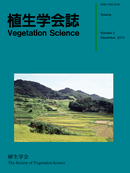Volume 29, Issue 2
Displaying 1-5 of 5 articles from this issue
- |<
- <
- 1
- >
- >|
-
Article type: Article
2012 Volume 29 Issue 2 Pages 75-90
Published: December 25, 2012
Released on J-STAGE: January 06, 2017
Download PDF (1660K) -
Article type: Article
2012 Volume 29 Issue 2 Pages 91-103
Published: December 25, 2012
Released on J-STAGE: January 06, 2017
Download PDF (2212K) -
Article type: Appendix
2012 Volume 29 Issue 2 Pages 123-
Published: December 25, 2012
Released on J-STAGE: January 06, 2017
Download PDF (78K)
-
Article type: Article
2012 Volume 29 Issue 2 Pages 105-109
Published: December 25, 2012
Released on J-STAGE: January 06, 2017
Download PDF (541K)
-
Article type: Article
2012 Volume 29 Issue 2 Pages 111-117
Published: December 25, 2012
Released on J-STAGE: January 06, 2017
Download PDF (905K)
- |<
- <
- 1
- >
- >|
